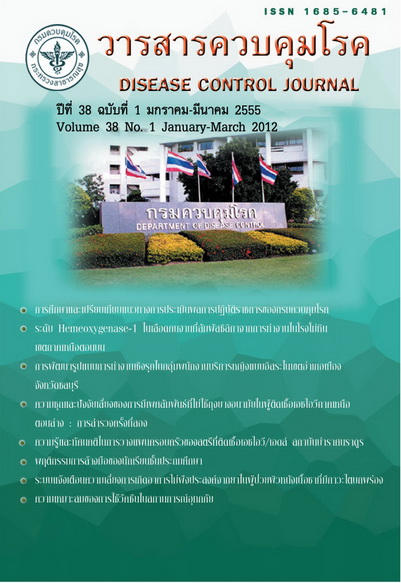Hand-Washing Practice of Elementary Schoolchildren
Keywords:
Hand washing, SchoolchildrenAbstract
Schoolchildren were at risk of being infected with various diseases resulting in having more severe symptoms than adults. Proper hand washing with water and soap would reduce the chance of such infection. This study aimed to observe hand-washing practice of schoolchildren attending grade 1-6 and to determine their knowledge and attitudes towards hand washing. Four elementary schools locating in Bangkok and its vicinity were the target sites. Results of the study would be used as a guideline for the preparation of health education materials for a long-term campaign in the future. Materials and methods included a one-week exhibition in each school, providing a soap dispenser and liquid soap at appropriate wash basins and submitting questionnaires. Hand-washing practice after using toilet were recorded prior to and after the exhibition. The results showed that prior to the exhibition, schoolchildren had little knowledge about hand washing. After the exhibition, their knowledge increased to a good level. About 94.04% replied that they should wash their hands before eating, 90.62% implied that washing hands after playing with pets was essential, and 86.90% responded that washing hands after the toilet was important. Although 82.54% of schoolchildren answered that they should wash their hands with water and soap, but 58.62% of them still believed that washing hands with water alone was good enough. Moreover, 41.27% of them thought that they should wash their hands 3 times daily. Regarding hand-washing practice of schoolchildren prior to the exhibition, most of them (59.18%) washed their hands with water alone while 38.23% did not wash at all. Only 2.60% used water and soap. After the exhibition, the percentage of schoolchildren who washed their hands with water and soap was greatly increased to 61.03. Raising awareness of schoolchildren on proper hand washing on a regular basis would lead to their good personal hygiene.
Downloads
References
2. ภูษิต ประคองสาย และ กัญจนา ติษยาธิคม. "ดัชนีสินทรัพย์" เครื่องมือชี้วัดเศรษฐานะของครัวเรือนไทย. สำนักงานพัฒนานโยบายสุขภาพระหว่างประเทศ กระทรวงสาธารณสุข (cited 2012 March 4) Available from: http:// ihppthaigov.net/presentation/attachresearch/ 85/PPT/PPTl.ppt
3. สายสุนีย์ สารวนางกูร, ดนยา ธนะอุดม. การศึกษาพฤติกรรมการดูแลตนเองของเด็กนักเรียนชั้นประถมศึกษาปีที่ 1-6 กรณีศึกษา โรงเรียนวัดเกาะสุวรรณาราม กรุงเทพมหานคร. วารสารการส่งเสริมสุขภาพและอนามัยสิ่งแวดล้อม 2541; (cited 2010 July 26); 21(3): (about 10 screens). Available from: http://advisor.anamai.moph.go.th/213/ bookVol21 No3.html
Downloads
Published
How to Cite
Issue
Section
License
Articles published in the Disease Control Journal are considered as academic work, research or analysis of the personal opinion of the authors, not the opinion of the Thailand Department of Disease Control or editorial team. The authors must be responsible for their articles.


.png)



